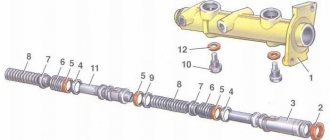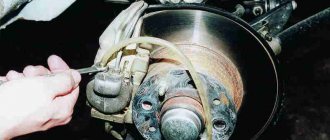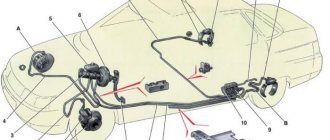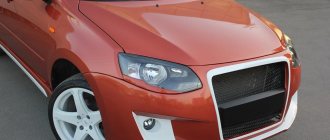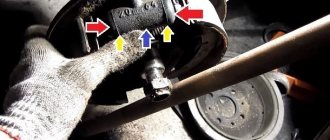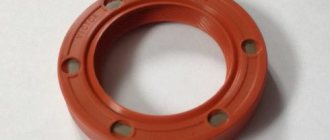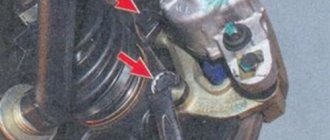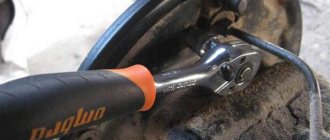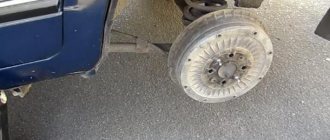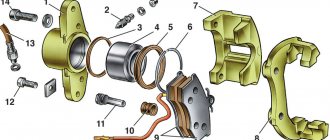The safety of the driver and passengers of the vehicle directly depends on the performance of the braking system. After a certain mileage, its components wear out, one of which is the caliper. Nevertheless, it is quite possible to repair the brake caliper, although most often it fails due to the process of souring of the guides or pistons.
Why is this dangerous in practice? If this unit malfunctions, the brake pads begin to wear unevenly. The same goes for brake disc wear. As for the pads, increased wear may be observed, for example, on the outside compared to the inside. Uneven wear indicates that the pistons are putting too much pressure on only one of the pads, while the other does not take part in the process. Urgent repair or replacement of the caliper is required, without waiting for it to completely jam.
About the reasons for caliper failure
This brake system component can break down due to improper maintenance or due to insufficient quality. The main reasons why caliper repair may be required are as follows:
- improper operation, which is associated with filling the guides with poor-quality lubricant - because of this, the boot swells and later “sours”;
- in the future, repair of the brake calipers may be necessary due to moisture getting on the guide, which leads to a breakthrough of the boot;
- Another reason is the piston itself, the body of which is also vulnerable to moisture getting inside;
- low-quality working fluid (brake) can corrode the piston from the inside if the concentration of water in it exceeds the norm.
Video tip for DIY caliper repair:
How to change the front brake cylinder
Judging by user requests, Kalina owners practically do not experience any breakdowns related to the front brake wheel cylinder. It is safe to say that the unit installed at the factory is quite reliable and must be replaced in exceptional cases. It is for such cases that I decided to write this article.
First, as usual, below is a list of the necessary tools:
- Jack
- Balloon key
- Head 13, TORX E14 with wrench
- Open-end wrench for 15 and 17
- Flat blade screwdriver
The procedure for removing and installing the front brake cylinder of the Lada Kalina
- First of all, we lift the front part of the car from the side where we will carry out the repair, after slightly loosening the wheel bolts.
- Unscrew all the wheel bolts completely and remove it.
- Now you can unscrew the brake hose and hang it upside down so that the fluid does not flow out so much:
- After which we can begin to unscrew the bolts securing the cylinder itself, where we will need a TORX E14 head with a knob. You will have to apply quite a lot of force to break these bolts, since the tightening torque is considerable. Although all Kalina repair instructions say that you first need to remove the cylinder and caliper assembly, and only then, holding it in a vice, unscrew the bolts. But judging from my practice, this does not need to be done if you have the necessary tools.
- Then, having previously bent the square locking washers, we unscrew the cylinder mounting bolts from above and below with a 13mm wrench, holding the internal nuts from turning with a 17mm open-end wrench. More details are shown in the photo below:
Now you can remove it and, if necessary, replace it with a new one. Installation is carried out in the reverse order of removal.
If it was not possible to change the Kalina brake cylinder using this method and the bolts with the TORX profile still did not give in, then you can do everything as written in many manuals. Remove it together with the caliper and clamp it in a vice, of course - this way there is a greater chance of unscrewing it.
You will need: a 14mm wrench, an 18mm socket socket, a large screwdriver, and a wrench for wheel bolts.
1. Loosen the bolts on the front wheel from the caliper side, place wheel chocks under the rear wheels. Raise the front of the car, place it on supports and remove the wheel.
2. Insert a screwdriver between the inner brake pad and the brake disc, slide the pad inward and thus push the piston from the working cylinder into the cylinder.
3. Remove the brake hose holder from the bracket on the shock absorber strut.
4. Loosen the hose connector on the working cylinder.
5. Unscrew the two bolts for securing the pad guide to the steering knuckle and remove the caliper by unscrewing its working cylinder from the brake hose end.
Immediately plug the hole in the hose nozzle using any method to prevent brake fluid from leaking out.
6. Install the caliper in the reverse order.
Before installing the caliper, screw the brake hose end into it and tighten it. When installing the caliper, make sure that the brake hose is not kinked.
7. After installation, restore the brake fluid level in the reservoir of the main brake cylinder, after which remove air from the brake hydraulic drive.
Repair of caliper guides
They are not difficult to detect - these are special bolts that are attached to the ears of the case. They need to be changed as soon as pockets of corrosion become noticeable. The repair process will look like this: unscrew the old guide and insert a new one in its place.
The main thing is not to forget about high-quality lubrication, and also check the condition and tightness of the anthers - there should be no cracks or tears on them.
Do-it-yourself caliper repair - preliminary inspection
The return movement of the piston in this unit is ensured by a cuff. Firstly, it creates a tightness, and, secondly, it acts as a kind of spring. When the piston moves, it undergoes a slight deformation, but then returns to its previous state, slightly pressing it into the body. Determining the malfunction is quite simple - if you hang the wheel, it should rotate freely as soon as you press or release the brake pedal. There should be no signs of overheating on the discs themselves, otherwise you will need to repair the caliper yourself.
When conducting a visual inspection, we must make sure that there is no noticeable difference in the thickness of the outer and inner pads. The piston should move so that when pressed it easily sinks into its body. Its surface should not have noticeable traces of dirt or corrosion particles. You also need to conduct a superficial inspection of the boot and ensure its integrity.
DIY caliper development procedure
Let's move on to a description of the repair itself. The algorithm will be something like this:
- First you need to lift the car using a jack and unscrew the wheel, locking the steering wheel in the extreme position.
- The mounting spring is removed, and the surface near the brake hose is thoroughly cleaned. To do this, you can blow it with compressed air.
- The brake hose must be clamped with a clamp to prevent leakage of working fluid.
- We continue to repair the caliper ourselves. After this, unscrew the bolt that secures it and remove the hose itself to the side. It is necessary to ensure that dirt particles do not penetrate inside it.
- After this, the caps on the guides are removed, and they themselves are unscrewed using a 7 mm hexagon.
- Using a screwdriver, we recess the piston, moving its body away from the disk to a sufficient distance. You can begin dismantling the old caliper.
- First, take it out of the case and check for moisture. We take the piston out of the housing. To do this, you can remove it from the disk without disconnecting the caliper from the hose. Just press the brake pedal and it should fall out on its own. How to clamp a brake hose? Any tight clamp will do, you can even use the one that is used to secure caps to wheel rims at a tire shop. You can use a vice in which to firmly clamp the body, and remove the piston itself with pliers. Or use compressed air, making sure that the part is not damaged during removal.
- We take out the old cuff, first removing the remaining working fluid. We thoroughly clean the surface in which the protective cover was located and the cuff seats. We rinse and blow with air, after which you can install a new cuff.
- When repairing the front caliper, lightly water the working surfaces of the piston with brake fluid. The piston itself is laid strictly vertically and slightly recessed. We put a protective cover on top. In this case, you need to make sure that the rubber band does not jam.
- Now the piston can be recessed completely, but you need to be careful to prevent the boot from twisting.
- We unscrew the brackets that are equipped with the caliper. We clean the surfaces on which the pads move. Care must be taken not to damage the threads in which the guides are attached. The bracket is screwed into its original place.
- We lay the block, making sure that it has taken its position and is not stuck anywhere. The guides must be cleaned of the slightest particles of dirt. The caliper is put on the bracket, and its guides are tightened with your fingers. We put on the caps and fix the springs. Don't forget to put grease under the brake pistons boot and remove any excess grease from around it.
- All that remains is to put the hydraulic fluid hose back in place and bleed the entire system with a few presses of the brake pedal. We lower the car to the ground using a jack and check the level of working fluid in the tank - refill if necessary. This completes the caliper rebuild.
Replacing guides and their lubrication
So, the first thing you need to do is remove the wheel bolts. Then lift the car with a jack, and finally unscrew the bolts and remove the front wheel. Then, using a flat-head screwdriver, bend the locking washers of the caliper bolts and unscrew the top bolt, as shown in the photo below.
We disengage the brake hose from the front strut, then use a screwdriver to push the cylinder down a little so that you can then tilt the bracket up without any problems.
And we fold it back, as mentioned above.
Now we have access to the upper caliper pin. With a slight movement of your hand, you can remove it by slightly pulling it to the side, overcoming the force of the boot.
Now that the finger is removed, thoroughly rinse it with cleaner and the boot, if it is intact. If necessary, take a new finger and boot.
Now you can apply new lubricant in small quantities so that excess does not get on the active working surfaces (brake pads and discs). For this procedure, I used MC1600 lubricant, which at one time was actively advertised in videos on YouTube and on third-party Internet sites. But I took it not because of advertising, but because of the lack of more or less normal lubricants in the store at the time of purchase.
According to the stated characteristics, the operating range of this lubricant is from -50 to 1000 °C. By the way, I didn’t expect that the cost of this bag is only 80 rubles. I thought it was several times more. Although, I can’t say that it’s particularly cheap! If you are constantly servicing the brake system while on the road, then of course it is more profitable to buy a large tube. If I'm not mistaken, it costs about 600 rubles per 100 grams.
This same bag will be enough to service the calipers of your Kalina for a year for sure!
You should not be overzealous, as excess may end up on the working surfaces, which will lead to a decrease in braking efficiency, and you will have to remove the residue with a cleaner or other degreaser.
Now you can put your finger in its place.
The lower finger changes in a similar way, so you are unlikely to encounter any difficulties when carrying out this repair! The effectiveness of the lubricant used can only be judged after long-term use, so we won’t rush to conclusions!
In order to replace the caliper brackets , we jack up the part of the car that we will work with or lift it on a lift. We remove the wheel. The front brake caliper bracket on Kalina is an integral part of the brake cylinder. The guides along which the caliper runs and the pads are inserted into it. The bracket itself is screwed to the steering knuckle. Next, you will learn how to repair the caliper bracket yourself.
Restoring a brake caliper is a rather complex and lengthy process, therefore, if the caliper has burst, is deformed, or the caliper mounting bolts are broken, then it is better to simply replace it with a new one. Replacing the caliper bracket on a VAZ is quite simple.
- Turn the wheels for ease of operation. Remove the brake caliper . To do this, unpin the two guide bolts
The design of this brake element
There are two types of disc calipers - front and rear, their design and repair method are slightly different, but their main elements are the same:
- The housing in which the piston (cylinder) is mounted.
- Bypass valve.
- Sealing ring.
- Piston (cylinder).
- Cylinder boot.
- Retaining ring.
- Frame.
- Pressure bar.
- Pads.
- Guide boot.
- Guides.
- 14. Fastening bolt.
- Brake hose.
The difference between the rear disc caliper is the presence of a parking brake.
Therefore, the piston (4) has a special thread through which it is screwed onto the parking brake rod (1). Thanks to this, it can operate under the influence of two drives - mechanical (parking) and hydraulic.
Causes of failure
The caliper as an element of disc brakes is subjected to significant temperature loads, as well as exposure to external adverse factors: dirt, dust, moisture, chemicals. All this happens due to the fact that his device does not allow him to be protected from these negative phenomena. If there is significant overheating, as well as if the boot ruptures, the lubrication of the guides may disappear.
Improper maintenance of the guides, in which some craftsmen manage to stuff inappropriate lubricant into their boots: graphite or similar, leads to their swelling and souring, after which they jam or knock when suddenly activated.
A rupture of the piston boot causes dirt and moisture to enter it. After which it stops working - it starts to jam or, conversely, knock.
Repair kit
Replacing a caliper is a drastic measure; often you can limit yourself to repairing and replacing its components. Basically, the standard repair kit includes rubber elements:
- cuffs,
- anthers,
- protective rubber bands of the fitting,
- piston sealing rings.
But depending on the necessary repairs, they may include:
- retaining rings,
- clamping brackets,
- guides,
- directly the pistons themselves.
Thanks to the repair kit, you can significantly save and improve the operation of this brake system unit.
Signs of trouble
The breakdown of the caliper components and their impending repair can be understood by some signs that occur during braking:
- The car pulls and pulls to the side when braking.
- It feels like when braking you have to put more force on the pedal or, conversely, less.
- The brakes rattle or knock when driving over bumps or when stopping.
- The brakes are jamming, which will be indicated by possible skidding.
- The appearance of brake fluid leaks on the wheel.
- Feedback in the pedal, expressed in a strong pulsation when pressing the brake.
If these symptoms appear, you should not delay repairing faulty caliper elements. You must first figure out why this happened and make repairs immediately. You can learn more about the signs and causes in the attached videos at the end of the article.
Replacing the working (Front) brake cylinder on a viburnum
Welcome! Working brake cylinder - popularly called simply the front cylinder, there are two such front cylinders on front-wheel drive cars, one is on the left brake disc and the other on the right (In the rear there are also working cylinders on both wheels, but since we are talking about the front part, we don’t take the rear into account), thanks to them braking is carried out, if you delve into the principle of operation of the brake mechanism, you can understand that the brake fluid (It is not compressible) presses on the brake cylinder (This is when you press the brake pedal , if you do not press the pedal, then the liquid will not press on the cylinder) and the piston located in this cylinder comes out, and therefore presses on the brake pads and thereby brakes.
Note! To replace this cylinder with a new one, you will need to take some tools, namely: A set of wrenches which must contain keys “13”, “17”, etc., and you will also need a hex key of size "on 10"!
Summary:
Where is the brake wheel cylinder located? You have probably already noticed that we constantly mention the word worker, this is all due to the fact that there are only five brake cylinders in the car (it is in the front-wheel drive ones that VAZ produces; foreign cars usually have much more of these cylinders) and four of them there are workers and one main one, if the worker fails there is nothing to be afraid of, the machine will still slow down but only the wheel on which the cylinder has failed will not be, but if the main one suddenly becomes unusable (Usually they jam in the position when the rod extends all the way , to put it simply, this is when you press the brake pedal and as soon as you remove your foot from it and it still remains in the pressed position and the car continues to brake, this indicates that the master cylinder is jammed), then all four wheels are immediately either blocked and the car brakes sharply (This is in the best case), or the car loses all its brakes and the pedal becomes stone (There are different outcomes, but basically, as we have already said, the pedal falls to the floor and the car slows down), for clarity, the entire braking system of the car The Lada Kalina is shown in the diagram below, on which the main brake cylinder itself is shown under number 4, and the brake calipers are shown under numbers 6 and 1, where the working cylinders are located, as you read the article you will learn in more detail where exactly they are located and How are they removed from the car?
When should a brake wheel cylinder be replaced? Firstly, if it is leaking, then immediately go to the auto shop and replace it with a new one, it is not so difficult to determine that the cylinder is leaking, just periodically look under the car and if you have alloy wheels, not stampings, then sometimes look at the brake calipers, they should be dry and there should be no foreign moisture on it, if you notice moisture, then remove the wheel and look in more detail where it is leaking, various things can leak, starting from the brake hose and ending with just the working cylinder, in general there is boot (Indicated in the photo below by an arrow) you can only see it if you remove the caliper from the brake caliper (In this article we will teach you how to read the caliper, just read on), so if brake fluid flows through this boot, then the cylinder is faulty and needs replacement, by the way, without getting under the car, you can also understand if there is some kind of malfunction in the brake system, firstly, listen to the sounds when braking, strangers or those that were not there before should not be there now, in addition, look at the reservoir where the brake fluid is be, it should go away very slowly, and if literally in a week everything leaks out, then look at the brake system of your car, other signs of a faulty brake wheel cylinder are as follows: if one of the wheels does not work when you press the brake, then the wheel cylinder is clearly jammed, and also if one of the wheels brakes constantly, unlike the others (That is, you do not press the brake, but the wheel brakes, although it should not do so), then most likely the problem is all in the cylinder and it first needs to be inspected (Maybe it has rusted and therefore no longer moves).
If the brakes rattle
This type of brake has pressure springs or floating calipers.
They are responsible for securing the pads to the caliper body. The reason for their failure is metal fatigue or poor quality. As a result, they lose their elasticity and stop pressing the pads against the body. Because of this, the pads rattle at the slightest passage of irregularities and may come into uneven contact with the disc, which will lead to the appearance of a shoulder or grooves on it. Also in this case, the staples themselves may rattle.
What should you do when your brake calipers or pads rattle? If it is not possible to replace them, then you should try to loosen them with your own hands using pliers to make them more rigid. To do this, you need to pull them out of their seats, unclench them and insert them into place, after which they will stop rattling for a while.
Design, principle of operation and main reasons for replacing a brake caliper in Kalina
In Kalina, the front braking mechanism is based on a floating front caliper. This means that the cylinder and piston in each of them are in one copy. The latter, when pressing the brake pedal, presses the pad against the disc from the inside, and the impact from the outside is achieved due to the displacement of the caliper relative to the disc along the guides. When the pedal is released, the piston returns to its original position and the pads move away from the discs.
The main malfunction that may lead to replacement of the brake caliper is souring of the piston in the cylinder. In this case, it either does not act on the pad when you press the brake pedal, or does not return back, constantly pressing the pad against the disc. Sometimes incorrect operation of the caliper is associated with souring or severe contamination of the guides. In this case, there is no need to change the caliper itself, but the symptoms may be similar.
The piston (cylinder) is faulty
Poor quality of brake fluid, the appearance of rust on the surface when the boot of at least one piston (cylinder) ruptures or as a result of prolonged downtime of the machine entails its partial jamming.
This will initially be heard when its operation is delayed, when the pads begin to knock on the disc. In order to make the repair yourself in this case, you need to disassemble the caliper and pull out the rusty piston; this must be done after the guides have been unscrewed and the boot and retaining ring have been removed.
If the cylinder still moves even slightly, you can squeeze it out using a compressor by inserting a hose into the hole for supplying brake fluid. This can also be done without first disconnecting the housing from the brake system; you just need to press the pedal, after which the created pressure will squeeze the cylinder out of its seat. If it is tightly jammed, then a preventive measure can be soaking it in gasoline and other similar liquid.
It is worth considering that the rear caliper piston cannot be removed, but is simply unscrewed along the threads with pliers or a similar tool. After this, you need to wash the cylinder seat and clean it of dirt and rust. It is also worth doing with the piston (cylinder) itself. Next you need to insert the cylinder into place. It would be useful to replace its boot with a new one during assembly. You can see this in more detail in the attached video.
Replacing caliper pins and boots
I think there is no need to explain once again that due to poor lubrication of the caliper fingers, certain problems can arise, for example:
- uneven brake pad wear
- tight movement of the bracket and even wedging it
- wear of the fingers, which will lead to rattling and knocking of the caliper
If there is enough factory lubricant in the guide pins, it can last up to 100,000 km. But there are times when practically new cars find themselves without lubrication in these parts. That is why it is better to check everything yourself. Also, lubricant can “leave” through a torn finger boot, so their integrity must be constantly monitored.
If you decide to replace the guide pins, as well as the caliper boots on your Kalina, then for this small repair you will need the following tool:
- 13 and 17 mm wrench
- Flat blade screwdriver
- Lubricant for caliper pins
- Brake cleaner (if equipped)
Replacing guides and their lubrication
So, the first thing you need to do is remove the wheel bolts. Then lift the car with a jack, and finally unscrew the bolts and remove the front wheel. Then, using a flat-head screwdriver, bend the locking washers of the caliper bolts and unscrew the top bolt, as shown in the photo below.
Guide faulty
The main problem if the brake does not work can be jamming and souring of the caliper guides.
Repairing this malfunction with your own hands will not be difficult. By the way, in this case there is no difference when disassembling both the front and rear calipers. To do this, you need to unscrew and pull out both guides. Clean them from dirt or poor-quality lubricant, remove and replace the torn boots with new ones, after filling them with special grease for calipers.
Signs of a faulty caliper
Signs of a faulty brake caliper:
- increased braking distance;
- difficulty rolling;
- the car pulls to the side when braking;
- pedal vibration when braking;
- grinding noise in the caliper area when driving: it is worth noting that the reasons can be different, from a trapped stone to banal wear of the pads, but wear of the pads can be caused by a faulty caliper;
- characteristic signs of overheating on the brake disc;
- uneven wear of pads from one caliper;
- excessive heating of the disk.
replacing brake discs 13″ to 14″
To upgrade from 13" to 14" brake discs you will need:
- brake disc 260mm (14” in people)
- caliper bracket from VAZ 2112 (officially “brake pad guide”)
- some tools
- Straight arms
This article is especially for those who want to have a minimum of hemorrhoids during this process.
| Loosen the wheel mounting bolts. Raise the car with a jack. Unscrew the wheel nuts. We remove the wheel and put it under the front suspension (just in case, otherwise you never know. It’s better to lay a board between the wheel and the suspension). |
| Next, take the head (or socket wrench) and unscrew the two caliper mounting bolts (located on the back side). |
| The second bolt is not indicated in the photo; it can be easily seen by bending down or feeling it with your hand. On the left is a photo with the caliper already removed for clarity. |
| Next you need to unscrew the two guide pins. Do not under any circumstances try to unscrew them with just a 7mm spanner! Take and put on two keys at once, or even better if you find a long head on “7”. |
These pins are screwed into the hub; they simply pass through the brake disc and press it against the hub, helping to put on the wheel when replacing it. It wouldn’t hurt to shed these pins a couple of times on both sides with a WD tool and at the same time shed the mounting diameter of the brake disc on the hub.
If you were able to unscrew the pins, consider half the job already done (on a car with a mileage of less than 20,000 km, the pins can be unscrewed quite simply, but if the car, like mine, has a mileage of around 55,000 km, and is also somehow adjusted by AvtoVAZ, you will be able to unscrew them It’s not easy.
Now we begin to knock on the brake disc from the inside with a heavier hammer through a piece of wood. The main thing is not the force of the blow, but the symmetry of the blows on opposite edges of the disc. The disc has a very tight fit (a normal brake disc has a groove for the hub of 58.6 mm, the hub has a groove of 58.5 mm + corrosion). We knock on the hub from the inside, turn it 180° (if you prefer, you can knock at least every 30° turn). In the holes of the wheel bolts you can clearly see how tightly the disk is pressed to the hub, and you need to knock on the side where the pressure is stronger.
Having removed the disc, we can say that the hardest part is over.
Use a metal brush to clean the mounting hole on the hub and put on a new disc.
In my case, the original 240 mm brake disc was a miserable sight; in just two sets of pads, it managed to burn blue several times, which was facilitated by the idiotic setting of the brake force regulator at the factory. As a result, the small 240 mm brake disc took on the majority (more than 80% of the car’s kinetic energy).
Visually, the difference between a 240mm (popularly 13”) disc and a 260mm (popularly 14”) disc is this:
